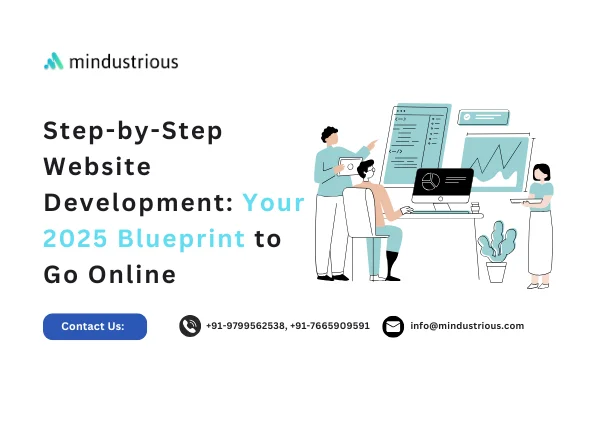Summary: The programming language Python combines simplicity and strength and has built significant popularity throughout the years since debut. Python Python Language finds application throughout multiple areas including data science and artificial intelligence as well as web development work. |
Python stands out as an ideal language for web development candidates because of its simple and readable nature together with its rich collection of libraries and frameworks. So, Mastering Python: A Comprehensive Guide to Web Development
how is Python Language used in web development?
Thanks for reaching out. I'm Sushil. I've been working for 8 years in lead generation which allowed me to explore multiple technology domains including web development. The powerful programming language Python has become one of the main options used in creating web applications because of its versatility. If you can’t find software development solutions, you can reach out!
We will tell you about Python's application in web development while also introducing the important frameworks and tools along with libraries that establish Python as a preferred language for web developers. We will demonstrate Python's strength by working through specific code examples.
Why Choose Python Language for Web Development?
Before diving into Python’s specific role in web development, let’s take a moment to understand why it is a popular choice among developers:
- Easy to Learn: Python Language uses syntax which is both clean and simple to understand making the language highly suitable for beginners. Web developers experience more efficient building timelines while needing fewer debugging sessions when they use this tool.
- Versatile: Python Language supports developers in executing numerous web development functions which cover backend coding and automation on the front-end. With Python Language developers are able to design full web applications including both server-side processing along with user interface creation.
- Extensive Libraries: The extensive libraries and frameworks of Python Language provide powerful solutions to handle sophisticated assignments like database administration authentication mechanisms and website data extraction.
- Scalable and Efficient: Python Language provides solutions for small developer projects as well as maintaining large high-traffic websites. The integration of robust frameworks with cloud platforms creates straightforward scaling solutions.
- Community Support: An extensive active Python Language community leads the ongoing development of the language. Multiple resources offer developers support which simplifies resolution of programming issues as well as delivers information about new developments.
Python Web Frameworks (Mastering Python: A Comprehensive Guide to Web Development)
A framework consists of ready-to-use tools and libraries developers use to create web applications both more quickly and efficiently. Python Language offers multiple web frameworks that each deliver optimum performance with different functionalities. Here’s how is Python Language used in web development:
1. Django
Python developers favor Django because it stands as one of their most widely adopted web application frameworks. Following a "batteries-included" philosophy Django ensures users receive every built-in function required to develop complete web applications when they start.
Key Features of Django:
- Fast Development: The automatic components supplied by Django including admin panels alongside user authentication and form management streamline code development for programmers.
- Security: The Django web framework comes equipped with numerous security mechanisms to prevent common web attacks including SQL injection as well as cross-site request forgery (CSRF) threats combined with cross-site scripting (XSS).
- Scalability: Django manages high web traffic effectively while offering simplicity in scaling operations. Instagram and Pinterest count among the popular sites which use Django as their main web framework.
- Built-in Admin Interface: Django provides an intuitive built-in admin panel which lets both developers and site administrators handle day-to-day site content tasks with ease.
Here’s a basic example of a Django app:
from django.shortcuts import render from django.http import HttpResponse
def index(request): return HttpResponse("Hello, welcome to my Django site!") |
2. Flask
Flask functions as a minimalist framework with adaptable options. Flask requires developers to implement their database connections and form validation but this design provides developers full control over how to handle these tasks in their project. Flask works perfectly as a framework for constructing applications of medium size as well as smaller applications.
Key Features of Flask:
- Simplicity: Due to its straightforward setup Flask becomes the top choice for novice developers.
- Modular: Flask enables developers to expand its capabilities through additional extensions according to project requirements.
- Flexibility: Developers have the freedom to select their personal technology stack including databases and extension libraries when building their projects.
Here’s an example of a simple Flask app:
from flask import Flask
app = Flask(__name__)
@app.route('/') def hello(): return 'Hello, World!'
if __name__ == '__main__': app.run(debug=True) |
3. Pyramid
Pyramid functions as a flexible and scalable lightweight Python web framework. Developers planning to design simple apps while deploying extensive web systems will find Pyramid fitting their requirements.
Key Features of Pyramid:
- Flexibility: With Pyramid technology developers maintain control of which components they deploy and can establish connections with diverse tools.
- Security: Pyramid framework provides built-in support mechanisms for user authentication authentication as well as authorization together with security policy management.
- Scalability: Pyramid appropriately handles applications of considerable size and enterprises find Pyramid suitable for their needs.
4. Web2py
Developers have all essential tools to create web applications through Web2py since this complete web framework contains built-in IDE support along with web interface interaction capabilities and database abstraction functionality.
Key Features of Web2py:
- Built-in IDE: The built-in IDE of Web2py enables users to develop, test and launch applications through their web browsers without interruption.
- Ease of Use: Web2py provides straightforward installation and utility so developers can start projects quickly.
Python Libraries for Web Development (Mastering Python: A Comprehensive Guide to Web Development)
Web developers benefit from Python which provides numerous libraries that ease web application development. Multiple libraries offer Python developers powerful tools for managing databases while processing images and executing HTTP requests under one roof.
1. Requests
The Requests library represents one of the principal Python packages developers turn to when they need to perform HTTP requests. The Requests module simplifies API communication while managing authentication header settings and cookie persistence tasks.
Example of using Requests:
import requests
response = requests.get('https://api.example.com/data') data = response.json() print(data) |
2. Beautiful Soup
Web scraping and the parsing of HTML and XML documents is done through the Beautiful Soup library. This library provides tools to pull information from HTML documents so that it takes on a structured form.
Example of using Beautiful Soup:
from bs4 import BeautifulSoup import requests
url = 'https://example.com' response = requests.get(url) soup = BeautifulSoup(response.text, 'html.parser')
# Extract all links from the page for link in soup.find_all('a'): print(link.get('href'))
|
3. SQLAlchemy
This helps people work with databases through Python objects because this Object-Relational Mapping (ORM) library enables simplified database operations.
Example of using SQLAlchemy:
from sqlalchemy import create_engine, Column, Integer, String from sqlalchemy.ext.declarative import declarative_base from sqlalchemy.orm import sessionmaker
# Set up database connection engine = create_engine('sqlite:///mydatabase.db') Base = declarative_base()
# Define a table using SQLAlchemy ORM class User(Base): __tablename__ = 'users' id = Column(Integer, primary_key=True) name = Column(String) age = Column(Integer)
# Create tables Base.metadata.create_all(engine)
# Create a session Session = sessionmaker(bind=engine) session = Session()
# Add a new user new_user = User(name="John Doe", age=28) session.add(new_user) session.commit() |
4. Jinja2
The Jinja2 Python library functions as a strong templating engine used extensively with web frameworks including Flask and Django. The design of Jinja2 separates presentation layers from core application logic through HTML template content rendering.
Example of using Jinja2:
from jinja2 import Template
template = Template("Hello, {{ name }}!") output = template.render(name="World") print(output) |
Python in Front-End Development
Backend web development primarily uses Python but this programming language also serves a purpose in front-end web development. Web developers use Python frameworks Django and Flask to create applications which incorporate front-end tech tools including JavaScript and HTML and CSS.
Integrating Python with Front-End Tools
Web applications require backend logic through Python and interactive user interfaces made with HTML CSS and JavaScript for the front end. Through Django and Flask frameworks developers can connect JavaScript tools like React or Angular to their server-side code.
How Python Supports RESTful APIs
Today's web applications mostly use Application Programming Interfaces for system-to-system communication. Application developers frequently choose Python to construct RESTful APIs because these APIs strictly follow representational state transfer (REST) principles.
Example of creating a simple RESTful API using Flask:
from flask import Flask, jsonify
app = Flask(__name__)
@app.route('/api/v1/resource', methods=['GET']) def get_resource(): return jsonify({"message": "This is a RESTful API"})
if __name__ == '__main__': app.run(debug=True) |
Through this example developers can learn how to construct an API endpoint which delivers JSON responses. Python simplifies API development broadcasters that enable communication between applications and services as well as front-end systems.
Best Practices for Python Web Development
Developing web applications with Python Language requires adherence to best practices for delivering clean efficient code that is easy to maintain. Here are some key practices to follow:
- Use a Web Framework: Frameworks Django and Flask offer structural support for your applications while presenting tools to manage common tasks including database operations and user authentication.
- Write Unit Tests: Through writing tests developers verify code functionality and detect bugs before they develop into bigger problems.
- Use Virtual Environments: Virtual environments create a separation for your project dependencies which simplifies management and prevents conflicts between packages.
- Handle Security: Perform all user input sanitation and validation tasks during processing and utilize robust password protection techniques together with implementation of CSRF protection features.
- Keep Code Modular: Segment your application into multiple reusable modules for better maintenance and clearer code reading.
Wrapping Up
Because of its straightforward design capabilities alongside versatile applications and extensive framework and library support Python Language stands as the optimal programming language for web development. Python offers the necessary tools to developers building both compact applications and large enterprise systems to create web applications that are both robust and scalable as well as secure. Hope so, now you know how is python used in web development.
Frameworks such as Django, Flask and Pyramid along with libraries like Requests Beautiful Soup and SQLAlchemy can make development processes faster so developers can dedicate their time to building great user experiences. Mastering Python: A Comprehensive Guide to enhances web development by making it faster to execute while remaining simple to access for users at all skill levels and inherently pleasant to practice.



